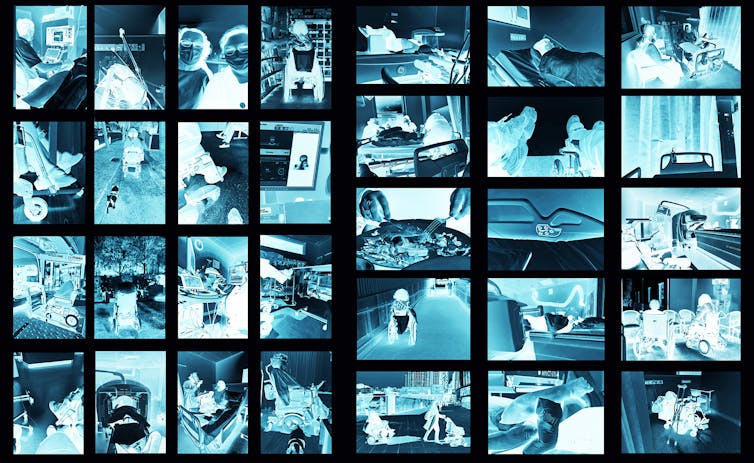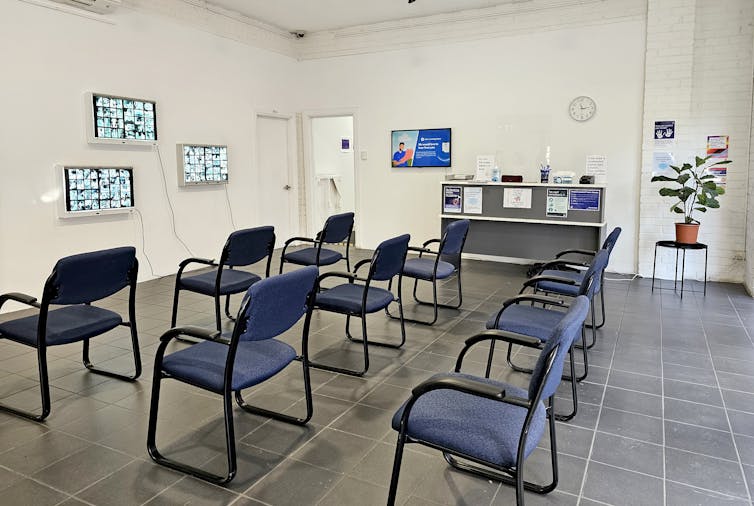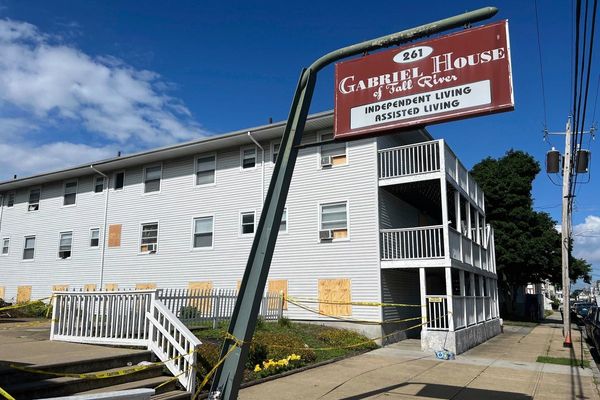
I have spent a lot of time in waiting rooms. Not only because my mum used to be a medical receptionist for a doctor for the first 17 years of my life. She was also disabled, and a single mother, and we lived with my grandparents.
My grandfather was blind and had dementia. My grandmother had Lewy body dementia. Their daughter, my mum, survived poliomyelitis at 18 months old and now has post-polio syndrome, which affects polio survivors decades after recovering from initial infection.
Among other things, I have learnt from my family that caregiving is a two-way street. They cared for me and I cared for them. I still care for my mum and she still cares for me.
The waiting room has been a metaphor for my life, and in my new artworks I explore the concept of waiting.
The art of waiting
Waiting rooms as a carer are very different to the experience of being a patient. I stand, sit and lay next to the care-receiver, witnessing someone else’s experience. I am the advocate, note taker, facilitator, taxi driver, ticket taker. The person who tells the receptionist we are here (because the bench is too high if you are a wheelchair user). The person who makes sure they speak to my mother, not me.
Being a carer is political, and I prepare for the experience in the waiting room.
There are three million carers in Australia: approximately one in every eight people is currently giving care. But that number isn’t definitive due to underreporting. Not everyone who cares identifies as a caregiver.
If you aren’t already giving or receiving care, it is probable that one day you will be.
Waiting is contemplative: it is feeling anxiety, it is sitting, it is pacing, it is waiting to be called to another room where something else happens, or (fun) more waiting.
When does waiting start and end? At the start or end of a diagnosis, a solid idea, or a plan? Are we just always stuck in the waiting room? Waiting for a medication to work, waiting to see if symptoms persist, waiting for something to work.

There is hope in the waiting, even when the waiting seems infinite.
Caregivers actively wait for the duration of time that it takes to give care, and the care-receiver actively waits for care. Time travels differently for caregivers and receivers: it moves to and with another’s time.
The time it takes to wait for an appointment; waiting for your number to be called; waiting for your care-receiver’s way of moving; waiting for a caregiver. It is constant and consistent waiting. It is constant and consistent time, yours and not yours. It is a liminal space driven by the very action of waiting for another. It is limbo with the definitive action (care), a definitive need without a definitive time.
Waiting for art
My artwork, Life’s a Waiting Room, invites gallery visitors to experience the complexities of waiting as a carer.
The installation comprises three photographic works and a participatory installation of a waiting room. The photographic works are three x-ray boxes that reflect on my lived experience in waiting rooms.
In each x-ray box, there are images of me waiting with members of my family: old photographs that reflect on the fact that waiting doesn’t just happen in the waiting room.
The waiting is also outside medical spaces.

In the harder times of waiting, I would take photos to revisit later and reflect on what we had experienced and witnessed. It helped me revise and see the invisible aspects in image form.
They are from waiting rooms, medical tests, out in the world, and at home. I inverted the images and made them look like x-rays. X-rays reveal the inner body.
With this I want to show the inner workings of care and waiting from my personal familial image archive.
Each member of my family has/had difficult medical needs. I learnt about my mortality very early on in my caregiver experience, as I was faced with my own waiting room needs.

Both waiting and care are invisible. Waiting rooms are a space where the experience of waiting for care is visible.
In my installation, you take a ticket at Life’s a waiting room clinic. You sit and wait for your number to be called. The screen flashes a number, but it never displays the number of your ticket. The audience is invited to sit for as long as they are willing.
Life is a Waiting Room is in The Local 2025 at the McGlade Gallery, Sydney, until August 17.
This article is part of Making Art Work, our series on what inspires artists and the process of their work.
Danica I. J. Knežević does not work for, consult, own shares in or receive funding from any company or organisation that would benefit from this article, and has disclosed no relevant affiliations beyond their academic appointment.
This article was originally published on The Conversation. Read the original article.







